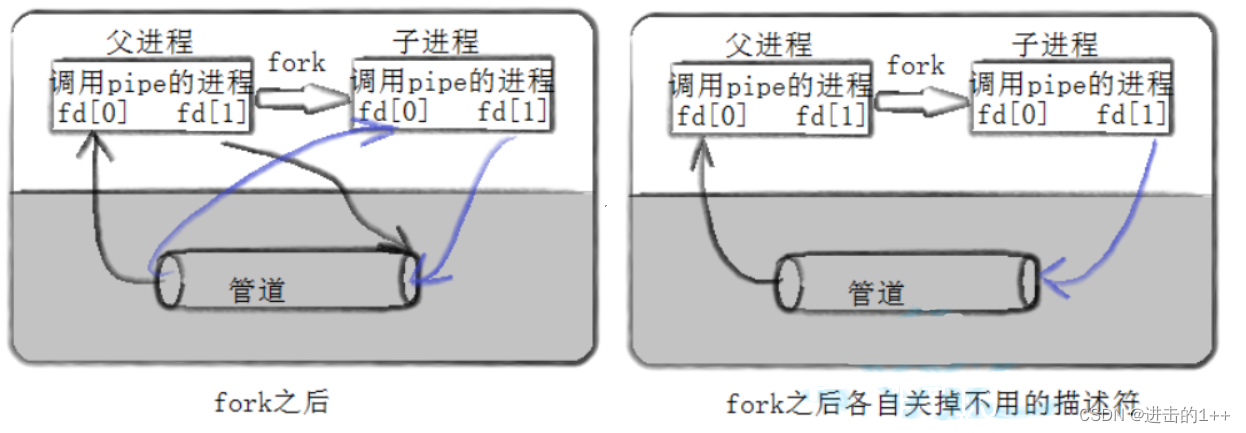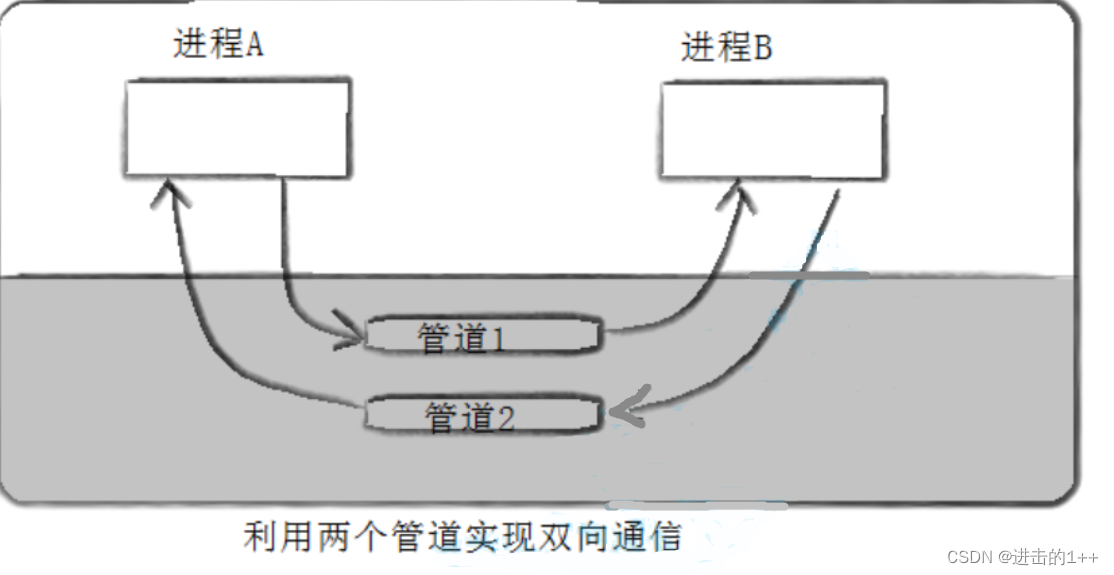详解管道
原创一,进程间通信的目的
- 数据传输:一个进程需要将它的数据发送给另一个进程
- 资源共享:多个进程之间共享同样的资源。
- 通知事件:一个进程需要向另一个或一组进程发送消息,通知它(它们)发生了某种事件(如进程终止时要通知父进程)。
- 进程控制:有些进程希望完全控制另一个进程的执行(如Debug进程),此时控制进程希望能够拦截另一个进程的所有陷入和异常,并能够及时知道它的状态改变。
进程间通信的必要性:
若没有进程间通信,那么也就无法使用并发能力,无法实现进程间协同。传输数据,消息通知等。
进程是具有独立性的,虚拟地址空间和页表保证了其独立性,因此,进程间通信的成本是比较高的。
想要让两进程间能够通信,那么其必定要能够看到同一份 “内存” 。这份所谓的“内存”不能属于任何一个进程,它应该是共享的。
进程间通信的发展:
- 管道
- System V进程间通信
- POSIX进程间通信
管道:
匿名管道pipe
命名管道
System V IPC:
System V 消息队列
System V 共享内存
System V 信号量
POSIX IPC:
消息队列
共享内存
信号量
互斥量
条件变量
读写锁
二,管道
管道是Unix中最古老的进程间通信的形式。是Linux原生就能够提供的。其有一个入口,一个出口,是单向通信的,也可以说是一种特出的半双工通信。
管道的原理:
我们在上面提到,两进程之间能够进行通信,那么两进程之间就得都能看到同一份资源?那么怎么让两进程看到同一份资源呢?
在fork之后,创建出来的子进程会继承父进程的大多数内容,这其中就包括文件描述符表,那么文件对象会被拷贝给子进程吗?显然是不会的,这样做是没有意义的。
我们在创建子进程之前分别以读写方式打开同一个文件,子进程继承之后,其也能够这个文件的文件描述符,有了文件描述符,我们是不是就能够访问这个文件了!!!我们让父进程进行写,那么就关闭其读的那个文件描述符,让子进程读,那么就关闭其写的那个文件描述符。这样,父子进程间就能够就行通信了。这样通信方式我们叫做匿名管道。
管道的本质是一种文件。
下面我们来简单的实现一个匿名管道:
使用pipe系统调用来创建匿名管道。
#include<iostream>
#include<fcntl.h>
#include<unistd.h>
#include<cassert>
#include<cstring>
#include<sys/types.h>
#include<sys/wait.h>
using namespace std;
int main()
{
//创建匿名管道
int pipefd[2];//0读--1写
int n=pipe(pipefd);
assert(n!=-1);
cout<<"creat pipe success"<<endl;
(void)n;
//创建子进程
pid_t pid=fork();
assert(pid!=-1);
if(pid==0)//子进程
{
//子进程负责读
close(pipefd[1]);//关闭写端
char buffer[1024];
while(true)
{
//sleep(3);
ssize_t n=read(pipefd[0],buffer,sizeof(buffer)-1);
assert(n!=-1);
if(n>0)
{
buffer[n]='\0';
cout<<"child get a message["<<getpid()<<"]"<<"father#"<<buffer<<endl;
}
if(n==0)
{
cout<<"write quite,me quite"<<endl;
break;
}
}
close(pipefd[0]);//可有可无
exit(0);
}
//父进程写
close(pipefd[0]);//关闭读
const char* message="I am sending message";
int count=0;
while(true)
{
ssize_t n=write(pipefd[1],message,strlen(message));
sleep(1);
count++;
if(count==5) break;
}
//读写完成,退出
close(pipefd[1]);
pid_t ret= waitpid(pid,nullptr,0);
assert(ret>0);
return 0;
return 0;
}运行结果:
写慢读快时

我们发现写慢读快时,读端不会继续写,而是停下来等待写入。
当我们让写快,读慢时(即读时休眠时间长一些)

一次会将管道中的所有数据都读出来。管道的大小是有限制的,当管道被写满时,便不会再写,而是等待读。
当把写端关掉,读端进程会直接退出。
当把读端关掉,OS会关掉写进程。
因此管道可以让进程间协同,提供了访问控制。 管道提供的是面向流式的通信服务,其生命周期随进程。
从管道读数据是一次性操作,数据一旦被读,它就从管道中被抛弃,释放空间以便写更多的数据。

站在内核的角度,管道的本质就是两个进程对同一个文件对象,一个进行写入,一个进行读取。
看待管道和看待文件一样,使用也是一样的,这也符合:Linux下一切皆文件的思想。
一个父进程可以和一个子进程通信,那么一个父进程能否和多个子进程分别通信?---可以的!
代码如下:
#pragma once
#include<iostream>
#include<functional>
#include<vector>
#include<string>
#include<unordered_map>
#include<unistd.h>
#include <utility>
#include<cassert>
typedef std::function<void()> func;
std::vector<func> callbacks;
std::unordered_map<int,std::string> desc;
void readSQL()
{
std::cout << "sub process[" << getpid() << " ] 执行访问数据库的任务\n" << std::endl;
}
void execule()
{
std::cout << "sub process[" << getpid() << " ] 执行url解析\n" << std::endl;
}
void cal()
{
std::cout << "sub process[" << getpid() << " ] 执行加密任务\n" << std::endl;
}
void save()
{
std::cout << "sub process[" << getpid() << " ] 执行数据持久化任务\n" << std::endl;
}
void lod()
{ desc.insert({callbacks.size(), "readSQL: 读取数据库"});
callbacks.push_back(readSQL);
desc.insert({callbacks.size(), "execule: 进行url解析"});
callbacks.push_back(execule);
desc.insert({callbacks.size(), "cal: 进行加密计算"});
callbacks.push_back(cal);
desc.insert({callbacks.size(), "save: 进行数据的文件保存"});
callbacks.push_back(save);
}
void showHandler()
{
for(auto& e:desc)
{
std::cout<<e.first<<'\t'<<e.second<<std::endl;
}
}
int Handersize()
{
return callbacks.size();
}#include<unistd.h>
#include<cstring>
#include<sys/types.h>
#include<sys/wait.h>
#include"task.hpp"
#define PROCESS_NUM 5
using namespace std;
int waitcommand(int waitfd,bool& quite)
{
int command=0;
ssize_t n=read(waitfd,&command,sizeof(command));
if(n==0)
{
quite=true;
return -1;
}
return command;
}
void SendCommand(int who,int fd,int command)
{
ssize_t s=write(fd,&command,sizeof(command));
std::cout<<"main process call"<<who<<"excule"<<desc[command]<<std::endl;
}
int main()
{
lod();
//pid : fd
std::vector<std::pair<int,int>> slots;
//多个子进程
for(int i=0;i<PROCESS_NUM;i++)
{
//创建管道
int pipefd[2];
int n=pipe(pipefd);
assert(n!=-1);
//创建子进程
pid_t pid=fork();
assert(pid!=-1);
if(pid==0)//子进程
{
//子进程读
close(pipefd[1]);
while(true)
{
//等命令
bool quite=false;
int command=waitcommand(pipefd[0],quite);//不写就等待
if(command==-1)
{
//std::cout<<"退出"<<std::endl;
break;
}
else if(command>=0&&command<=Handersize())
{
callbacks[command]();
}
else
{
std::cout<<"非法输入"<<std::endl;
}
}
//退出
close(pipefd[0]);
std::cout<<"write quite,me quite"<<std::endl;
exit(1);
}
//父进程写
close(pipefd[0]);
slots.push_back(std::make_pair(pid,pipefd[1]));
}
//随机派发命令
srand((unsigned)time(nullptr));
while(true)
{
int command=rand()%Handersize();//选择命令
int choice=rand()%slots.size();//选择子进程
//指派任务
SendCommand(slots[choice].first,slots[choice].second,command);
sleep(2);
}
//关闭所有写
for(auto& e:slots)
{
close(e.second);
}
//回收所有子进程
for(auto& e:slots)
{
waitpid(e.first,nullptr,0);
}
return 0;
}
命名管道:
命名管道与匿名管道的原理相同,都是通过让两个进程看到同一份资源,从而实现通信,但命名管道不再局限于父子进程之间,而是任意两个进程之间实现通信。
两进程看到相同的资源,是通过管道文件的路径从而实现的。
命名管道的本质也是一种文件,但不是普通的文件,普通的文件我们在读写时,会将内存数据刷新到磁盘中,但是我们的管道是不会的。因此其效率也是很高的。
管道文件的创建:
- mkfifo filename
- int mkfifo(const char *filename,mode_t mode);
下面是我们实现的命名管道的代码:
// 服务端接收消息
#include"comm.hpp"
#include"Log.hpp"
static void getmessage(int fd)
{
char buffer[1024];
while(true)
{
int n=read(fd,buffer,sizeof(buffer-1));
assert(n!=-1);
if(n>0)
{
buffer[n]='\0';
std::cout<<"["<<getpid()<<"]"<<"client say: "<<buffer<<std::endl;
}
else if(n==0)
{
std::cout<<"["<<getpid()<<"]"<<"client quit,me quit"<<std::endl;
break;
}
}
}
int main()
{
//创建管道
int n=mkfifo(ipc_path.c_str(),0666);
if(n<0)
{
perror("mkfifo");
exit(1);
}
log("管道创建成功",DEBUG)<<"step1"<<std::endl;
//打开管道进行读
int fd=open(ipc_path.c_str(),O_RDONLY);
if(fd<0)
{
perror("open");
exit(2);
}
log("打开管道成功",DEBUG)<<"step2"<<std::endl;
for(int i=0;i<Process_Num;i++)
{
int pid=fork();
assert(pid>=0);
if(pid==0)
{
getmessage(fd);
exit(1);
}
}
for(int i=0;i<Process_Num;i++)
{
waitpid(-1,nullptr,0);
std::cout<<"等待成功"<<std::endl;
}
close(fd);
log("关闭管道成功",DEBUG)<<"step3"<<std::endl;
unlink(ipc_path.c_str());
log("删除管道成功",DEBUG)<<"step4"<<std::endl;
return 0;
}//客户端发送消息
#include<iostream>
#include"comm.hpp"
#include"Log.hpp"
#include<cstring>
int main()
{
int fd=open(ipc_path.c_str(),O_WRONLY);
if(fd<0)
{
perror("open");
exit(3);
}
log("client 打开管道成功",DEBUG)<<"step5"<<std::endl;
std::string buffer;
while(true)
{
std::cout<<"client say:"<<std::endl;
std::getline(std::cin,buffer);
int n=write(fd,buffer.c_str(),buffer.size());
}
close(fd);
return 0;
}#pragma once
#include<iostream>
#include"comm.hpp"
#ifndef _LOG_H_
#define _LOG_H_
#define DEBUG 0
#define NOTICE 1
#define WARNING 2
#define ERROR 3
std::string mes[4]={
"DEBUG","NOTICE","WARNING","ERROR"
};
std::ostream &log(std::string message,int level)
{
std::cout<<"|"<<unsigned(time(nullptr))<<"|"<<mes[level]<<"|"<<message;
return std::cout;
}
#endif#pragma once
#include<iostream>
#include<sys/types.h>
#include<sys/stat.h>
#include<string>
#include<cassert>
#include<fcntl.h>
#include<unistd.h>
#include<sys/wait.h>
#define Process_Num 4
std::string ipc_path="./fifo.ipc";一个普通的全局的静态函数与普通函数的区别是:用static修饰的函数,限定在本源码文件中,不能被本源码文件以外的代码文件调用。
原创声明:本文系作者授权腾讯云开发者社区发表,未经许可,不得转载。
如有侵权,请联系 cloudcommunity@tencent.com 删除。
原创声明:本文系作者授权腾讯云开发者社区发表,未经许可,不得转载。
如有侵权,请联系 cloudcommunity@tencent.com 删除。
